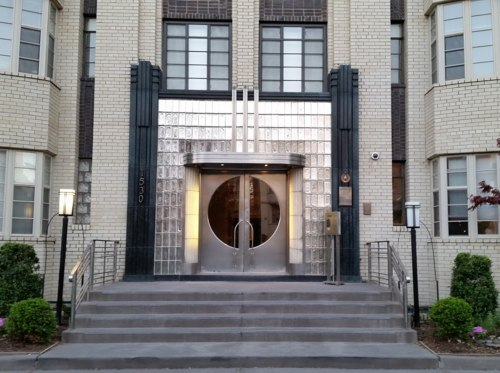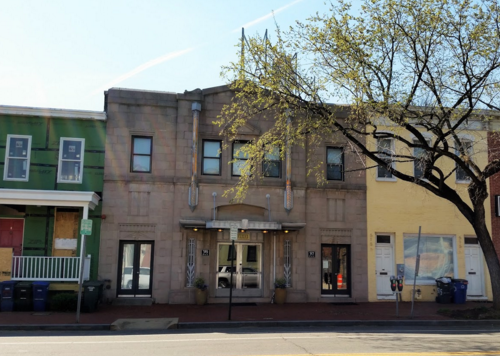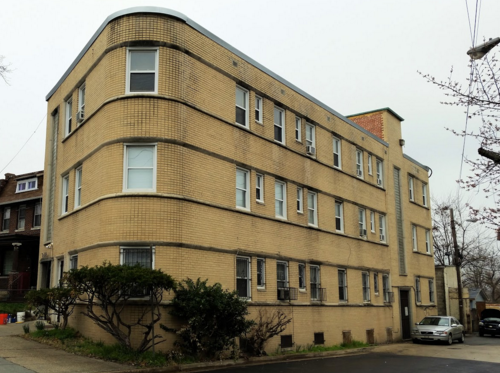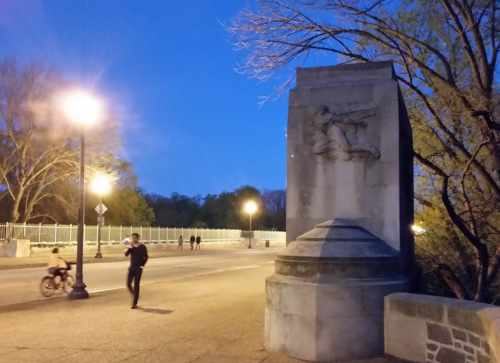Five examples of Art Deco architecture in the District

This Art Deco building was formerly the Home Theater, at 1230 C Street NE. It’s now a church. Image created with Google Maps. All other images by the author.
We first published this post on April 22, 2016. The architecture is still beautiful, so we're sharing it again.
DC’s wave of Art Deco architecture was short lived, but its influence is still all over the city today. The five structures below show the extent to which Washingtonians embraced the modern architectural style.
Art Deco developed in a more conservative manner in DC than other places, with architects compromising between radical modernists and traditional classicists. In vogue when DC was expanding to accommodate federal workers in the 1930s, Art Deco used geometric shapes and bold colors, as well as machine and ancient motifs—in particular, it drew inspiration for its more abstract details from non-western influences, especially Egyptian and Mesoamerican ones. Plastic, glass, and concrete were used in novel ways.
Federal buildings mixed Art Deco with classical design to make “Greco Deco.” Commercial buildings were the most enthusiastic with Art Deco designs, though the city failed to preserve most of them. Garden apartments showed Art Deco origins on entrances and rooflines. Vertical lines along buildings give the impression of height. Pyramid-like ziggurats break rooflines. Floral and transportation motifs were popular, and the “streamline” style used minimalist lines for exaggeration.
The Deco style preserved a stubborn belief in progress through the Great Depression: the economy was ailing, its thinking wet, but the United States would recover, industry would surge, and culture would bloom. A modern inferno raged in the future, but Art Deco propagated an elegant, jazzy style, grasping the past to forge the present.
The entrance of the High Towers (1530 16th Street NW), designed by architect Alvin Aubinoe in 1938. 
Around the Washington region, more than 400 Art Deco structures went up between 1925 and 1945. The best-known examples in the city are the Kennedy-Warren Apartments in Cleveland Park and the Hecht Warehouse Co. building (refurbished into loft apartments and retail space) in Ivy City. For less-popular examples of Deco, the following list pulls out subtle, but striking, Deco buildings.
1. The Chambers Funeral Home, Eastern Market
For those who wanted to be buried in Art Deco, the Chambers Funeral home was built in 1932 in Eastern Market. Designed by Leroy H. Harris and developed by W.W. Chambers, it’s since become an office for a rental company and features a chrome awning with metal floral motifs on its lights and facade.
2. 2412 Minnesota Avenue SE
Originally offices and stores, Frank Martinelli designed this building on Minnesota Avenue in Fairlawn in 1949, and A.G. Carozza developed it; it doesn’t have an official name. The slick curves in the building resemble the Hecht Warehouse, and glass block above the entrances were a common motif in Art Deco.
3. The Majestic, 16th Street NW
One of the most appealing Art Deco apartment buildings, the Majestic apartment building on 16th street is striking. The double rows of curved bay windows, recessed entrance, and ziggurats along the roofline demand attention.
4. The Duke Ellington Memorial Bridge, Calvert Street NW
The district also has an Art Deco bridge that connects Woodley Park and Adams Morgan. The Duke Ellington Memorial Bridge, built in 1935 and designed by Paul Cret, includes sculptures by Leon Hermant on its corners that combine ancient deities and modern technology. In one, a goddess races a car, and the bridge railings were done in Deco style.
A second Art Deco bridge, the Klingle Valley Bridge on Connective Avenue, includes Deco floral motifs. It was built in 1931 and designed by Paul Cret and Frank M. Masters.
5. The Library of Congress Annex, 2nd Street SE
For federal buildings, none can rival the Library of Congress Annex. Art Deco design is evident on its exterior, but its interior bursts with floral designs and painstaking ornamental design brings the building to life.
Other examples are less bold. The buildings were numerous enough to scatter across most neighborhoods in the city and pockets in Alexandria, Arlington, and Silver Spring. In the district, clusters can be found near 14th Street in Brightwood, Connecticut Avenue in Cleveland Park, Columbia Heights, Adams Morgan near Meridian Hill/Malcolm X Park, east of Glover Park, and downtown spreading east from the White House between New York and Pennsylvania Avenues.
DC’s Art Deco architects
A handful of architects dominated the DC. Art Deco scene. George T. Santmyers specialized in garden apartments, designing almost 50 of them in a 14-year period. The majority of them remain in use. Joseph Abel, like Santmyers, focused on apartments and designed a dozen. John Eberson designed 13 movie theaters, but only the AFI Silver Theatre and Cultural Center in Silver Spring still functions as one. Eberson narrowly triumphed over John J. Zink, who had 11 theaters to his credit. Only one, the Uptown in Cleveland Park, remains in use as a theater.
“For many of the architects active in Washington, Art Deco represented a series of decorative elements to be combined with traditional and radical approaches, from Renaissance revival to classical to the International Style,” Hanz Wirz and Richard Striner wrote in Washington Deco: Art Deco in the Nation’s Capital, an excellent resource for information on Art Deco’s development.
A map of Art Deco buildings, past and present, shows the reach of the style. Other highlights include an Art Deco influenced amusement park in Glen Echo, Maryland, the public schools of Greenbelt, Maryland, and an “America on Wheels” roller rink in Adams Morgan, now functioning as a grocery store and fitness center. D.C. isn’t known for Art Deco, but when residents learn the motifs, they notice buildings cropping up in unexpected places.
The Art Deco Society of Washington also promotes the style’s influence and offers tours, events, and a map of some notable (and metro accessible) Art Deco landmarks.






